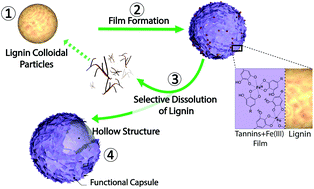当前位置:
X-MOL 学术
›
Green Chem.
›
论文详情
Our official English website, www.x-mol.net, welcomes your feedback! (Note: you will need to create a separate account there.)
Lignin nano- and microparticles as template for nanostructured materials: formation of hollow metal-phenolic capsules
Green Chemistry ( IF 9.8 ) Pub Date : 2018-02-20 00:00:00 , DOI: 10.1039/c8gc00064f Blaise L. Tardy 1, 2, 3, 4 , Joseph J. Richardson 5, 6, 7, 8 , Junling Guo 9, 10, 11, 12 , Janika Lehtonen 1, 2, 3, 4 , Mariko Ago 1, 2, 3, 4 , Orlando J. Rojas 1, 2, 3, 4, 13
Green Chemistry ( IF 9.8 ) Pub Date : 2018-02-20 00:00:00 , DOI: 10.1039/c8gc00064f Blaise L. Tardy 1, 2, 3, 4 , Joseph J. Richardson 5, 6, 7, 8 , Junling Guo 9, 10, 11, 12 , Janika Lehtonen 1, 2, 3, 4 , Mariko Ago 1, 2, 3, 4 , Orlando J. Rojas 1, 2, 3, 4, 13
Affiliation

|
Hollow polymeric, submicrometer-scaled capsules show promise in applications ranging from water remediation to drug delivery, and the preferred method for their synthesis includes templating from sacrificial particles. Such particles are typically non-renewable and the process of selective dissolution used to produce the capsules often requires harsh and/or toxic solvents. Thus, there is a critical need to develop inexpensive, sustainable templates that can be dismantled under mild conditions. Lignins have recently been introduced as renewable precursors for the synthesis of solid particles and can favorably substitute solid particles based on petrochemical (such as latex) or mineral (such as silica) precursors. Conveniently, widely available by-product streams of biomass processing can be used for the supramolecular assembly required for lignin particle formation. Herein, we introduce two common lignin sources (kraft and alkali lignins) as renewable and easily degradable particulate templates for the preparation of hollow polymeric capsules. The polymeric nanocoating, or wall of the capsules, was synthesized from renewable tannins, which self-assemble around the lignin particle template in the presence of metal ions, thereby coordinating into metal-phenolic networks (MPNs). The lignin template particles were easily degraded with aqueous or organic solvents under ambient conditions. Thus, the nanocoating assembly and template disassembly processes can be considered to be fully “green”. Finally, the synthesized hollow capsules were successfully utilized for water clean-up through the degradation of an organic dye, exemplifying a cost-effective and facile route for using environmentally friendly nanomaterials for environmental remediation.
中文翻译:

木质素纳米和微粒作为纳米结构材料的模板:空心金属酚醛胶囊的形成
中空的聚合物,亚微米级的胶囊在从水修复到药物输送的各种应用中均显示出了希望,其合成的优选方法包括从牺牲性颗粒中进行模板化。这样的颗粒通常是不可再生的,并且用于生产胶囊的选择性溶解过程通常需要刺激性和/或有毒的溶剂。因此,迫切需要开发可以在温和条件下拆卸的廉价,可持续的模板。木质素最近已被引入作为用于合成固体颗粒的可再生前体,并且可以有利地替代基于石油化学(例如乳胶)或矿物(例如二氧化硅)前体的固体颗粒。方便地 广泛使用的生物质加工副产物流可用于木质素颗粒形成所需的超分子组装。本文中,我们介绍了两种常见的木质素来源(牛皮纸和碱性木质素),它们是可再生和易于降解的颗粒模板,用于制备空心聚合物胶囊。聚合物纳米涂层或胶囊壁由可再生的单宁合成,可再生的单宁在金属离子存在下围绕木质素颗粒模板自组装,从而配位成金属酚网络(MPN)。木质素模板颗粒在环境条件下容易被水性或有机溶剂降解。因此,可以将纳米涂层组装和模板拆卸过程视为完全“绿色”。最后,
更新日期:2018-03-20
中文翻译:

木质素纳米和微粒作为纳米结构材料的模板:空心金属酚醛胶囊的形成
中空的聚合物,亚微米级的胶囊在从水修复到药物输送的各种应用中均显示出了希望,其合成的优选方法包括从牺牲性颗粒中进行模板化。这样的颗粒通常是不可再生的,并且用于生产胶囊的选择性溶解过程通常需要刺激性和/或有毒的溶剂。因此,迫切需要开发可以在温和条件下拆卸的廉价,可持续的模板。木质素最近已被引入作为用于合成固体颗粒的可再生前体,并且可以有利地替代基于石油化学(例如乳胶)或矿物(例如二氧化硅)前体的固体颗粒。方便地 广泛使用的生物质加工副产物流可用于木质素颗粒形成所需的超分子组装。本文中,我们介绍了两种常见的木质素来源(牛皮纸和碱性木质素),它们是可再生和易于降解的颗粒模板,用于制备空心聚合物胶囊。聚合物纳米涂层或胶囊壁由可再生的单宁合成,可再生的单宁在金属离子存在下围绕木质素颗粒模板自组装,从而配位成金属酚网络(MPN)。木质素模板颗粒在环境条件下容易被水性或有机溶剂降解。因此,可以将纳米涂层组装和模板拆卸过程视为完全“绿色”。最后,


























 京公网安备 11010802027423号
京公网安备 11010802027423号